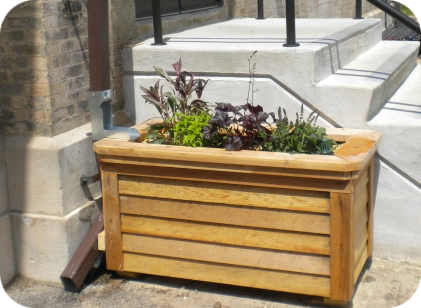Application: Buildings, houses, markets
Description: A downspout planter is a decorative garden planter filled with gravel, soil and vegetation that utilizes rainfall from the roof as irrigation. It is placed along or at the end of a downspout to capture the water before it enters the sewer. Downspout planters range from very simple planters on the ground to one or more planters along the downspout. Rainfall is captured by the planter, slowing water down, and allowing for infiltration and the capture of pollutants. It can be constructed in many sizes and shapes, and with various materials, including concrete, brick, plastic, lumber or wood. A planter box will last longer if it is lined with plastic as the soil will tend to be moist and will rot much quicker than a normal planter. Plastic lumber is an option as it will last indefinitely. An overflow outlet is important as the planter will be close to the building and could cause moisture problems if the overflow is not directed away from the building.
Contribution to climate resilience: A downspout planter reduces the velocity and quantity of rainwater flow, thus reducing erosion and excessive drainage issues associated with storms and heavy rains. It also cleans the water which passes through it, reducing water pollution downstream. Improved management of water is one of the best ways to improve resilience to likely changes in climate.
Supplementary sources of information:
http://www.grownyc.org/files/osg/green_infrastructure_techniques_WEB.pdf http://www.phillywatersheds.org/whats_in_it_for_you/residents/downspout-planters
Background image credit: https://flickr.com/photos/schuylkillwaters/6958995785
This resilience-building measure is sourced from the Water Resource Adaptation Guide (2019) published by the National Council for Sustainable Development at the Ministry of Environment in Cambodia. The full Guide is available to download at URL https://ncsd.moe.gov.kh/sites/default/files/2019-10/Water%20Resources%20Adaptation%20Guide_March%202019_En.pdf


